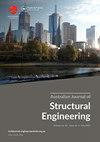Probabilistic constitutive law for masonry veneer wall ties
IF 0.9
Q4 ENGINEERING, CIVIL
Australian Journal of Structural Engineering
Pub Date : 2022-04-03
DOI:10.1080/13287982.2021.2021628
引用次数: 4
Abstract
ABSTRACT In a masonry veneer wall system, tie strengths and stiffnesses vary randomly and so are not consistent for all ties throughout the wall. To ensure an economical and safe design, this paper uses tie calibration experimental approach in accordance with the standard AS2699.1 to investigate the tie failure load under compression and tension loading. Probabilistic wall tie characterisations are accomplished by estimating the mean, coefficient of variation and characteristic axial compressive and tensile strength from 50 specimens. The displacement across the cavity is recorded, which resulted the complete load versus displacement response. Using the maximum likelihood method, a range of probability distributions are fitted to tie strengths at different displacement histogram data sets, and a best-fitted probability distribution is selected for each case. The inverse cumulative distribution function plots are also used along with the Anderson-Darling test to infer a goodness-of-fit for the probabilistic models. An extensive statistical correlation analysis is also conducted to check the correlation between different tie strengths and associated displacement for both compression and tension loading. Based on the findings, a wall tie constitutive law is proposed to define probabilistic tie behaviour in numerical modelling.砌体贴面墙铰的概率本构律
在砌体贴面墙体系统中,粘结条的强度和刚度随机变化,因此在整个墙体中粘结条的强度和刚度并不一致。为了保证设计的经济性和安全性,本文采用了符合AS2699.1标准的拉杆标定实验方法,对拉杆在压缩和拉伸载荷作用下的破坏载荷进行了研究。通过估计50个试件的平均值、变异系数和特征轴向抗压和抗拉强度,完成了概率壁系特征。记录跨空腔的位移,从而得到完整的荷载-位移响应。利用最大似然法,拟合了不同位移直方图数据集上的锚固强度的概率分布范围,并为每种情况选择一个最合适的概率分布。逆累积分布函数图也与安德森-达林检验一起用于推断概率模型的拟合优度。还进行了广泛的统计相关分析,以检查在压缩和拉伸加载下不同的连接强度和相关位移之间的相关性。在此基础上,提出了壁结本构律来定义数值模拟中的概率壁结行为。
本文章由计算机程序翻译,如有差异,请以英文原文为准。
求助全文
约1分钟内获得全文
求助全文
来源期刊

Australian Journal of Structural Engineering
ENGINEERING, CIVIL-
CiteScore
2.50
自引率
0.00%
发文量
31
期刊介绍:
The Australian Journal of Structural Engineering (AJSE) is published under the auspices of the Structural College Board of Engineers Australia. It fulfils part of the Board''s mission for Continuing Professional Development. The journal also offers a means for exchange and interaction of scientific and professional issues and technical developments. The journal is open to members and non-members of Engineers Australia. Original papers on research and development (Technical Papers) and professional matters and achievements (Professional Papers) in all areas relevant to the science, art and practice of structural engineering are considered for possible publication. All papers and technical notes are peer-reviewed. The fundamental criterion for acceptance for publication is the intellectual and professional value of the contribution. Occasionally, papers previously published in essentially the same form elsewhere may be considered for publication. In this case acknowledgement to prior publication must be included in a footnote on page one of the manuscript. These papers are peer-reviewed as new submissions. The length of acceptable contributions typically should not exceed 4,000 to 5,000 word equivalents. Longer manuscripts may be considered at the discretion of the Editor. Technical Notes typically should not exceed about 1,000 word equivalents. Discussions on a Paper or Note published in the AJSE are welcomed. Discussions must address significant matters related to the content of a Paper or Technical Note and may include supplementary and critical comments and questions regarding content.
 求助内容:
求助内容: 应助结果提醒方式:
应助结果提醒方式:


